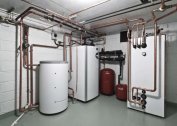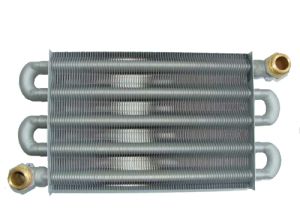
The main element of any of the heating systems is a special device - a heat exchanger for heating a house, in which heat is transferred from a heat generator to a heat carrier. A large number of different heating boilers are presented on the modern market, but all of their diversity does not limit the imagination of home craftsmen regarding the independent manufacture of such devices. In our article, readers will be asked to find out why a heat exchanger is needed in a heating system, how to make it with your own hands and how to connect it.
Heat exchanger function in the heating system
In home air heating systems, surface heat exchangers of the heating system are most often used, where thermal energy is transmitted through the surface of the metal walls of this device.
The principle of heating through a heat exchanger is most fully implemented in the design of gas, solid fuel or electric boilers. Water circulates through pipes curved in the form of a coil installed inside the heating unit and is heated by the temperature of the burning fuel. The heated coolant goes into the pipeline of the heating system, and it is replaced by the cooled water from the radiators in the heat exchanger.
Until now, in many individual homes, the stove remains the traditional source of heat. It is good for heating a small hut, however, in a multi-room cottage, its thermal capacity is insufficient. Therefore, in a private house, a heat exchanger in the heating system is needed in order to turn the stove into a full-fledged water heating boiler. The size and shape of a home-made heat exchanger for heating should fit into the dimensions of the fuel chamber of the furnace. Pipes and radiators can be connected to this device, and then heating the house will become more efficient.
Types of heat exchangers
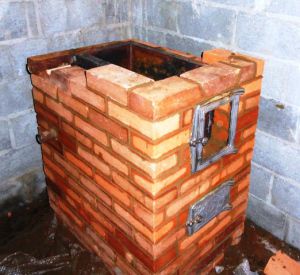
More practical water heat exchangers for heating. This is because water transfers thermal energy much better than air. However, an air heat exchanger for heating also finds application. In addition to water and air, a chimney heat exchanger is also used for heating, which is installed not inside but outside.
All industrial heating devices are equipped with heat exchangers, the design of which is maximally adapted for efficient heating of water.
In the factory, heat exchangers are made of copper. The pipe is a coil, across the bends of which there are many plates, providing a large area of heat transfer.
It’s almost impossible to build a home-made heat exchanger for heating in your home so that it is exactly like the factory one. Therefore, you have to choose an easier option.
System device
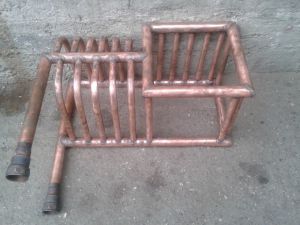
The principle of operation of a home-made heat exchanger is that the stove transfers energy to it from the combustion of firewood or coal, and the heated water diverges through pipes to all rooms. This heating method allows the inhabitants of the house to enjoy an even distribution of heat.In addition, all rooms warm up much faster, and fuel costs are reduced.
There are two ways to improve stove heating of a private house:
- build a furnace from scratch for a specific heat exchanger size;
- install a home-made heat exchanger made into the size of the furnace into the existing furnace.

Having made a heat exchanger for heating with his own hands, the homeowner can be sure that his stove with a water circuit will act no worse than a real solid fuel boiler. The only difference is that in the stove the location of the inlet of the heat exchanger will be slightly higher above the floor than in factory boilers. This is a fairly significant difference, which can affect the rate of natural circulation of the coolant.
The connection of the heat exchanger to the heating system must be done so that the cold water intake pipe (return) is located as low as possible.
Just as in a conventional heating system, an expansion tank must be installed at the top of the pipelines. It will compensate for the change in the volume of heated water and release air bubbles from the system. If heating through a heat exchanger with natural circulation is insufficient to heat a large cottage, you will have to install a circulation pump in the system.
To connect a home-made heat exchanger for heating, 2 fittings are used: one from the bottom (cold water inlet), the other from the top (hot outlet). When installing the heat exchanger, it is necessary to provide the necessary slope of the pipes, as required by the scheme.
Advantages of heating with a heat exchanger
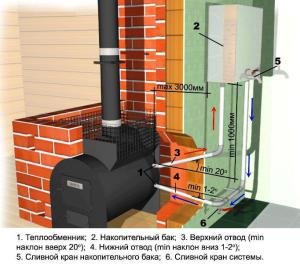
If you understand why you need a heat exchanger in the heating system, you can notice several obvious advantages:
- Ease of manufacture. If a furnace already exists in the house, then you will have to spend only on making a home-made heat exchanger and installing a heating system.
- Combined heating. In addition to heating the house from the surface of the stove, a water heating system will be added.
- A variety of fuels. You can heat the furnace with any solid energy, unlike boilers that focus only on a specific type of fuel.
- Beautiful appearance. Preserving the traditional look of the Russian stove can be useful when creating an interior in a national style.
Among the disadvantages of heating through a heat exchanger are: less high efficiency compared to factory boilers and the lack of automatic control over the intensity of heating of the coolant.
How to make a homemade heat exchanger

The shape of a heat exchanger for self-made heating can be different. The most common option is a register of several steel or copper pipes, but plate-type samples are also used.
The temperature in the combustion zone is very high, especially when coal is burning. Therefore, increased demands are placed on the metal from which the elements of the heat exchanger will be made, the rationality of its design and the quality of the welds.
Materials for the manufacture
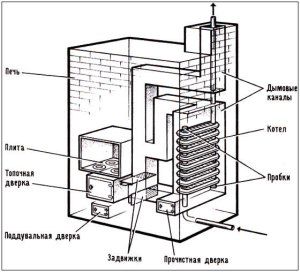
The task of water heat exchangers for heating is to ensure optimal heat transfer, and the degree of metal thermal conductivity is important in this process. For example, a steel pipe conducts heat 7 times weaker than a copper one. Therefore, with the same diameter of the pipe, to transfer the same amount of heat, you will need 25 meters of steel pipe instead of 3.5 meters of copper.
Copper heat exchangers are the most economical in operation, but also expensive. Heat exchangers made of steel pipe with a diameter of at least 32 mm are considered more accessible for independent manufacture.
If it is supposed to heat the furnace with coal, it is better to install a cast iron heat exchanger. This metal is stronger, and the walls of the device will not burn for a long time.
Heat exchanger power calculation
It is quite difficult to calculate the heat exchanger capacity for a heating system in advance. To do this, one must take into account too many factors: pipe diameter, coil length, metal thermal conductivity, fuel combustion temperature, coolant circulation speed, etc. The real ability of the heat exchanger to cope with its functions will be found out only after the heating system has been launched.
In the calculations, it can be oriented that 1 meter of a pipe with a diameter of 50 mm, which serves as a heat exchanger, will give 1 kW of thermal power.
You can take for example any known model of the boiler and, in accordance with its parameters, make your own home-made heat exchanger.
Design features
A heat exchanger for water heating at home, welded from smooth-walled pipes, is called a register. It looks like a kind of "lattice", and this is the most popular form of a home-made heat exchanger. In addition to this design, they also make simpler devices in the form of a rectangular or cylindrical tank. The main thing is that the surface area for heat exchange is as large as possible.
When making a heat exchanger with your own hands, several conditions must be observed:
- the width of the internal voids in the heat exchanger must be at least 5 mm, otherwise the water in it may boil;
- the pipe wall thickness should be at least 3 mm so that the metal does not burn out;
- a gap of 10–15 mm between the heat exchanger and the walls of the furnace should compensate for the expansion of the metal during heating.
Mounting Features
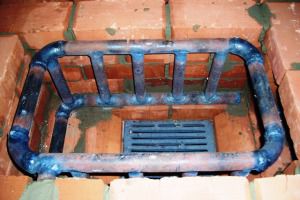
The easiest way is to install a heat exchanger simultaneously with the construction of the furnace. If you install it in an old oven, you will have to disassemble part of its brickwork.
Procedure:
- A tubular heat exchanger is installed directly on the prepared foundation of the furnace directly into the furnace cavity.
- With further laying of the rows of bricks, they leave room for the inlet and outlet pipes of the device.
- After the masonry is completed, the heat exchanger is connected to the heating system, the system is filled with water and a test furnace of the furnace is produced.
The video material offers to get acquainted with useful tips on self-manufacturing a heat exchanger:
So far, we have only talked about heat exchangers in a water heating system. Let's pay attention to other areas of their application.
Air heating
If you characterize the air heating system, we can say that it has more minuses than pluses. Air heat exchangers for heating are not common in the private residential sector, they have not yet become familiar.
The advantage of this system is the ability to combine heating with forced ventilation. However, possible errors in its design and installation can minimize the benefits. Fan noise is heard in the ducts, and temperature imbalance is felt in the rooms.
Heat exchangers for air heating exist direct heating as well as indirect. In the first of them, gas or diesel fuel burns directly in the heat exchanger itself. Other models use an intermediate coolant.
Chimney heat exchanger
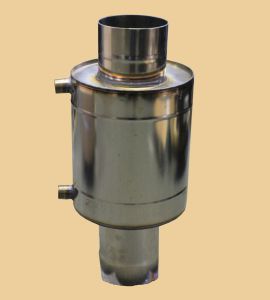
In the cottages and bathhouses of the “craftsmen" you can see a home-made water or air heat exchanger mounted on the chimney of a small stove. It turns out very profitable: the heat does not go away with the smoke, and part of it serves to heat the water.
By installing a heat exchanger in the chimney for heating, you can get a fairly large amount of hot water. Of course, this is not enough to warm the whole house, but enough to put one or two radiators in the dressing room.It is possible to use a heat exchanger for a chimney both for heating and for quick heating of water in a bathhouse.
Such a device can be very simple to manufacture. As a basis, you can take a segment of a large pipe with a diameter of 500-700 mm, or weld a tank from stainless steel. In the center of the structure there will be a vertical pipe corresponding to the diameter of the chimney, and two pipes should be welded on top and bottom.
Giving its temperature to the heat exchanger, the combustion products leaving the furnace quickly cool down. Because of this, draft in the chimney decreases and fuel combustion slows down somewhat.
Making a heat exchanger for do-it-yourself heating can be a way to arrange full-fledged water heating in the house without acquiring expensive equipment.


